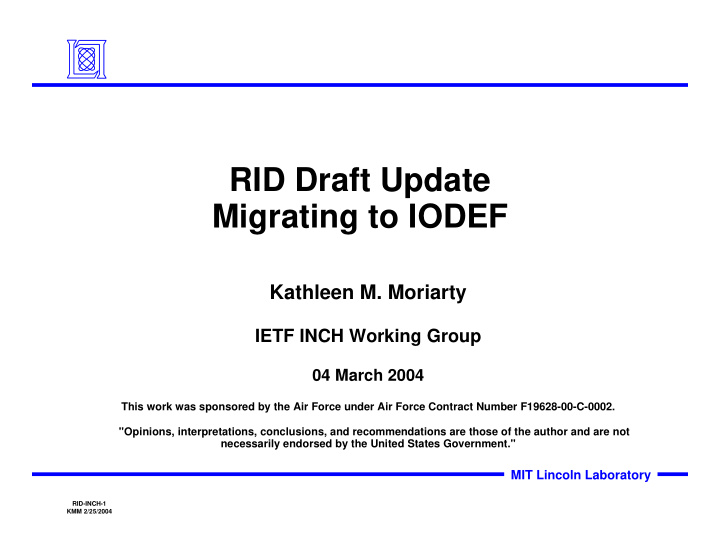



RID Draft Update Migrating to IODEF Kathleen M. Moriarty IETF INCH Working Group 04 March 2004 This work was sponsored by the Air Force under Air Force Contract Number F19628-00-C-0002. "Opinions, interpretations, conclusions, and recommendations are those of the author and are not necessarily endorsed by the United States Government." MIT Lincoln Laboratory RID-INCH-1 KMM 2/25/2004
RID Updates Purpose • RID and INCH • Messaging Format Changes • Packet based to XML – Define Extensions to IODEF Model • Communication Mechanism for RID Documents • Security Considerations • Consortiums – Privacy – MIT Lincoln Laboratory RID-INCH-2 KMM 2/25/2004
Real-time Inter-network Defense (RID) Trace Security Incidents to the Source • Stop or Mitigate the Effects of an Attack or Security Incident • Facilitate Communications between Network Providers • Integrate with existing and future network components • Systems to trace traffic across a network – NetFlow, Hash Based IP Traceback, IP Marking, etc. Intrusion Detection Systems Network devices such as routers and firewalls Provide secure means to communicate RID messages • Consortiums agree upon use and abuse guidelines – Consortiums provide a key exchange method – Trusted PKI, certificate repository, cross certifications MIT Lincoln Laboratory RID-INCH-3 KMM 2/25/2004
RID and INCH RID is used to communicate security incident handling • information between CSIRTs or NPs RID carries much of the same data as an IODEF document • RID requires a few additional data elements • Communication and proper transport of messages is in the • RID specification RID is now reformatted to use the IODEF specification • Packet based format to IODEF document – RID message types • Noted in a SOAP wrapper to an XML IODEF document – MIT Lincoln Laboratory RID-INCH-4 KMM 2/25/2004
RID Extensions to IODEF AdditionalData Class from IODEF used to define Extensions • IPPacket Class – Allows hex packets to be stored in the RID message in a format that will be expected by the recipient of a RID message Multiple packets may be sent in a single message NPPath Class – Purpose is to identify the path of the trace and to avoid loops TraceStatus Class – Method for providing approval status from upstream peer after a trace request is made MIT Lincoln Laboratory RID-INCH-5 KMM 2/25/2004
Communicating RID Messages SOAP Messaging Wrapper and XML Security • Method to transport messages – Provide integrity, authentication, authorization – XML digital signature, encryption, and public key infrastructure – Public Key Infrastructure • Provided by consortiums linking network providers for RID – messaging Message Types • Trace Request – Trace Authorization – Source Found – Relay Request – RID Systems Must Track the Requests by • Incident Number – Packet Contents – Completion Status – MIT Lincoln Laboratory RID-INCH-6 KMM 2/25/2004
Security Considerations Consortiums • Agreements between entities involved in RID peering – Provide a secure key exchange repository/system (PKI) – Peering agreements and policies between consortiums and across – national boundaries or jurisdictions System use guidelines • Privacy considerations – Abuse policies – Use policies may vary across national network or consortium – boundaries Automated method to allow enforcement of use agreements RID server security policies • Network based access controls – Hardened systems – Communication security considerations for the exchange of RID • messages and the underlying protocols MIT Lincoln Laboratory RID-INCH-7 KMM 2/25/2004
Summary Many updates from the previous version • Moved from packet based format to a solution based on IODEF – documents Extended the AdditionalData Class to accommodate the needs of RID – messaging Security will use XML Digital Signature and XML Encryption – PKI at the core of the security model, but provided by a consortium – Topology examples to address implementers questions – Extended information on system use and privacy considerations – Near Future Update will include • SOAP wrapper and more information on XML Security – Further specifications on automating a flag for system use – adherence guidelines May include additional examples of other message types – Any suggested revisions or clarifications – http://www.ietf.org/internet-drafts/draft-moriarty-ddos-rid-05.txt • MIT Lincoln Laboratory RID-INCH-8 KMM 2/25/2004
Recommend
More recommend